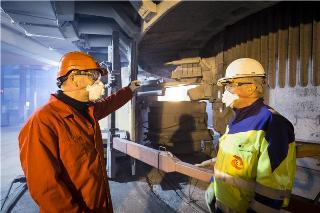Nov 4 2015
A dust extraction unit that exploits the laws of nature has made the indoor climate on the ‘shop-floor’ of the Thamshavn smelter in Norway 75 percent cleaner.
 The Norwegian silicon industry is reducing dust concentrations in the air around its furnace operators. In order to remove dust during tapping, Bernd Wittgens of SINTEF (left) and Halvard Tveit of Elkem and NTNU have led the development of a new extraction system that Elkem’s works at Thamshavn have been the first to adopt.
The Norwegian silicon industry is reducing dust concentrations in the air around its furnace operators. In order to remove dust during tapping, Bernd Wittgens of SINTEF (left) and Halvard Tveit of Elkem and NTNU have led the development of a new extraction system that Elkem’s works at Thamshavn have been the first to adopt.
Silicon that will be used to make everything from solar cells to sealants is drawn off from huge furnaces in Thamshavn and other Norwegian ferroalloy industry smelters. The white-hot material poured from the furnace is followed through the tap-hole by a cloud of greyish-white dust, which until now has been released into the smelting hall itself.
“Dust from the discharge stage has no immediate effects on health, but according to doctors it can be a long-term hazard, which is why we are looking for solutions that can reduce the amount of dust inhaled by furnace operators,” says Halvard Tveit, Elkem Group specialist and adjunct professor at NTNU.
A research programme led by SINTEF (see fact-box) has generated a new extraction system that captures more of the dust from the tap-hole than older systems.
Exploiting natural updraft forces
Elkem’s plant in Thamshavn in the County of Sør-Trøndelag was the first to adopt the new solution. Measurements have shown that the new extraction system has reduced the concentration of dust in the work-zone around furnaces by 75 percent.
“Our success lies in the way that we have managed to exploit the natural updraft forces in the dust and gas leaving the oven. We have quite simply played along with nature’s own laws,” says project manager Bernd Wittgens of SINTEF.
More efficient hood
The innovation is that the hood that collects the dust has been given a new design and a better location than those that have been the norm in silicon metal production.
The new system has also been adopted by Wacker's smelter in Holla in Sør-Trøndelag, and it will soon also be installed at Elkem’s plants in Salten and Bremanger. Although the principle itself has been developed and tested, some development work is still being done in order to optimise the solution.
Filter masks were the first stage
Halvard Tveit emphasises that the short-term dust-reduction measure in this industry has been the requirement that everyone in the vicinity of the tap-holes must wear a filter mask.
“We are also trying to automate the discharge process, in the hope that in the future we will be able to move the operators out of the area when metal is being tapped. But in any case, it will always be important to have an efficient dust-removal system,” he points out.
Like a storm
The dust that is emitted during tapping originates from the gas that forms inside the charge of the fucrnace. In addition to the smelt itself, the oven transforms every litre of solid raw material into 4000 litres of silicon-rich gas. When the gas emerges from the tap-hole, it is immediately combusted as it encounters the oxygen in the air of the smelting hall. The dust particles (silicon dust; see fact-box) is a result of this combustion process)
The less gas emitted by the oven, the less dust will be formed. According to Tveit, Norwegian research results have already made it possible to reduce the emissions of gas, and thus of dust too, from the tap-hole. The gas that still escapes may do so at a speed of up to storm strength, according to estimates made by SINTEF. The high flow velocity involved has been one of the challenges of the extractor project.
Underlying measurements and simulations
The idea for the new extraction system came from Elkem itself, and the subsequent research programme followed it up through a series of steps. First, it developed methods for making the necessary measurements at the tapping point. Then the measurement results were used as input for computer simulations, which in turn formed the basis of a prototype version. Early prototypes were tested at Elkem’s works in Salten and Thamshavn.
“If we had proceeded by trial and error, this could have become the world’s most expensive extraction system. Instead, we ended up within acceptable time and cost limits,” says Halvard Tveit.